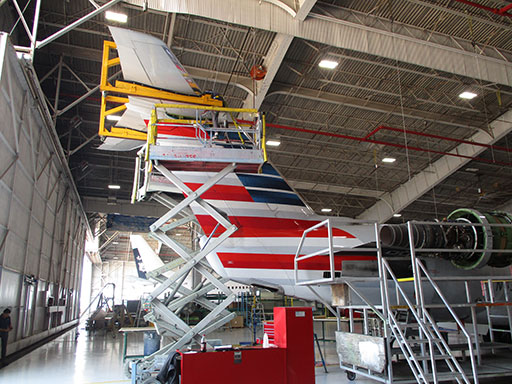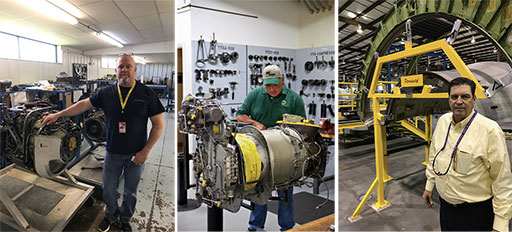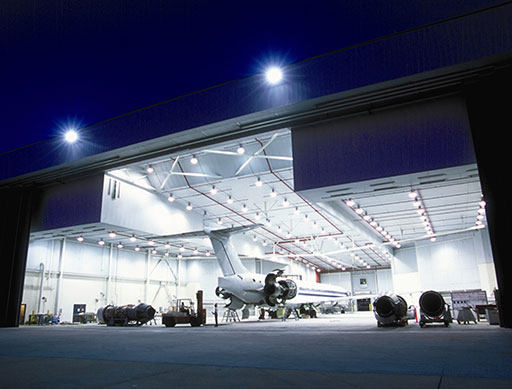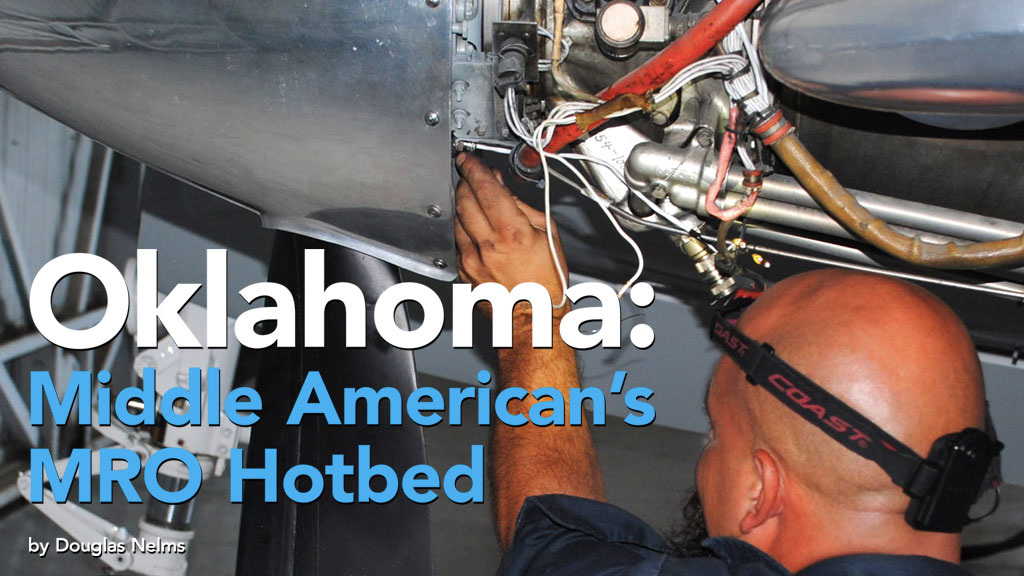The extension of tax breaks looks set to ensure that Oklahoma reputation as an aviation and MRO center will continue through the next decade.
Oklahoma solidly re-established itself as one of the most aviation friendly states in the nation on May 1, when Oklahoma Governor Mary Fallin signed Senate Bill 120 that extended special tax credits to employers and employees within the Oklahoman aerospace industry. That signing extends the tax credits until Jan. 1, 2026.
The state is currently home to over 500 aviation related companies, with a significant number involved in MRO work and/or spare parts production. Those companies employ more than 120,000 workers and generate over $27 billion in annual sales.

“Since 2010, this tax credit has generated $46.3 million in tax revenue while only costing the state $18.4 million. With such a great economic impact for our state, it is vital that we support this flourishing industry,” stated Governor Fallin. She added that the aerospace engineer tax credit plays a “key role in maintaining Oklahoma’s position as an internationally recognized hub for aerospace business” as well as creating hundreds of new, high-paying jobs for skilled Oklahomans.
“But Oklahoma goes beyond simply offering a tax credit to aerospace companies. Our robust CareerTech system works hand-in-hand with many aerospace companies to create and adapt the necessary training programs to produce a pipeline of talent. Our colleges and universities are developing their degree programs and coursework to better align with the skills needed to meet the needs of the industry,” she continued.
CareerTech is a state-owned and operated program that provides training for multiple industries, “but specifically for aerospace areas such as A&P training, sheet metal, avionics, and composites, as well as tailored training specifically for individual companies,” said Vince Howie, Aerospace & Defense director, Oklahoma Dept. of Commerce.
“Any aerospace company can send its employees to any of these schools basically for free. The state assigns a dollar value based on the number of new jobs a company is bringing into the state, then translates that into tuition waivers or dollars that can be used for training for the company,” he said.

It also serves specific needs of aerospace companies. “For instance, there was a company that bought some very specialized equipment from Germany, so we sent their employees to Germany to get trained on the equipment, all at no cost to the company,” he added. He noted that the state added its 59th CareerTech campus last year.
The state also hosts an Oklahoma Talent Acquisition Team tasked to provide companies needing new employees. Its mandate is to “provide a single point of contact for all human-resource needs, identify qualified talent and develop interview schedules,” along with other employment services.
The state, perhaps most famous for its university football teams and corn “as high as an elephant’s eye,” is a veritable hotbed of MRO activity. The two largest maintenance operations are Tinker AFB, home of the U.S. Air Force’s largest depot level maintenance facility [featured in AVM June/July 2017], and American Airlines’ primary maintenance facility with both already in expansion programs for new aircraft types.
Other MRO shops range from the very large, world-wide, companies such as AAR, with a large FBO and MRO operation at Will Rogers World Airport in Oklahoma City, to a very narrowly specialized Limco Airepair in Tulsa, a manufacturer of, and MRO repair station for, heat transfer products with 300 customers worldwide and growing at the rate of five new customers per month.
Why Oklahoma?
Ask MRO executives why they are located in the state and the tendency is to claim the standard: ‘Location, Location, Location.’
Susanne Palkowski, president and CEO of BizJet, a Lufthansa Technik subsidiary in Tulsa, noted that being in the middle of the country provides “a big advantage for doing engine work with the engine still on the wing.” BizJet does MRO work on Spey and Tay engines, plus tear down on CFM engines. Mark James, director of Operations for Intercontinental Jet in Tulsa, which does MRO work primarily on Mitsubishi MU-2, said that Tulsa is “as close to the middle of the country as we can be, with good airline support.”
But while location was cited as a major draw for the state, it is actually a bit of a myth. Yes, Oklahoma is dead center between the East and West Coasts. But so are Texas, Kansas, Nebraska and the Dakotas, all of which have first class airports and sophisticated highway and rail networks.
Most MRO operations in Oklahoma are located in or close to either Tulsa or Oklahoma City, with major airports providing rapid air service from both coasts as well as Canada and Mexico. Others, however, are deep in what’s best described as Oklahoma cattle country, away from the major airports but with ready access to connecting highway systems.
Mint Turbines is a relatively small engine MRO company located just north of Stroud, OK, dead center between Tulsa and Oklahoma City. Al Weser, vice president and general manager, said that they do work on both military and civil Honeywell T-53 and P&W PT6 engines that come in from South America, Mexico, Germany, Scandinavia, South Africa and Pakistan, as well as from Tinker AFB and Ft. Rucker, AL. These could be flown in to virtually any city in the United States that has a decent sized airport, then trucked to his facility.
Weser said that Mint Turbines is based in Stroud because it was started by three former military helicopter mechanics from that area. The company currently has about 50 employees, with annual revenues of about $20 million a year. “And we could double that with 75 people, easily.”
Vertical Aerospace is another MRO between Oklahoma City and Tulsa, specializing in nacelle component work primarily on Boeing and Airbus products, with about 90 percent MRO and 10 percent manufacturing, according to Mike Perry, general manager.
Perry said the central location near Bristow, which sits right along side an interstate highway as well as the famed Route 66, helps in dealing with customers in Mexico and Canada, “when dealing with Europe and South America, we don’t have as good of advantage, so we have to give them something in return.” This includes free freight from Miami, which allows them to compete against the Florida area. As for the two main airline hubs in Dallas/Fort Worth and O’Hare, “trucks go through here all day from Chicago or Texas.” Components come in from both international and domestic customers who send the components “either into Chicago, Dallas or Miami, and then they are trucked to here. Then it’s all about price and turn time.”
He said that Vertical Aerospace is in a “small business set-aside hub zone environment location,” which allows a good area for its 226,000 sq. ft. facility “where we can do anything from the tail cone to the nose cone on any size aircraft. So we have unlimited capacity, unlimited capabilities.”

King Aerospace in Ardmore, OK is decidedly off the beaten path, but relatively close to I-35, the north/south link between Oklahoma City and the Dallas/Fort Worth area. It is also located on Ardmore Municipal Airport with a 9,000 ft. runway that allows aircraft to fly in for paint or interior modification work. The company also offers full MRO work up to 757 sized aircraft, according to Roy Lischinsky, vice president of Operations.
Economic advantages
Besides the idea of being in ‘middle America,’ the three biggest attractions for MRO operators are the economic advantages provided by the state government, availability of highly trained workers, and cost of living.
Perry said that a major advantage to being in Oklahoma is the talent pool. Twelve of the state’s colleges and universities have aerospace programs, while a wide range of aircraft maintenance schools provide a steady source of young talent “so we can get them right out of school.” He also runs an internship, getting students out of schools such as Oklahoma State University’s aeronautical engineering program or Spartan College of Aeronautics and Technology.
AAR’s Stan Mayer said that there will be a lot of retirements of maintainers coming up in the next five years, and that there is “a good chance that 50 percent of the work force will be retiring in the next four to five years.” He noted that AAR has 700 people working in MRO, but that “we are constantly bringing in new people because of people moving over to Tinker (AFB). So we have a younger work force.”
AAR promotes the growth of young people going into aviation maintenance by hosting career days with the local high schools as well as working with all of the technical schools “to find a path for young people getting into the aviation world,” he said.
Along with tax credits and a strong pool of maintainer talent, the state also enjoys a cost of living status weighted in its favor. Normally a low cost of living equates to a low salary base, with tends to neutralize the benefits. However, the cost of living in Oklahoma is roughly 25 percent less than more expensive states, while salaries only range from 10-15 percent less than nationwide. An Oklahoman Department of Commerce document cites examples showing an aerospace mechanical engineer earning a median hourly wage of $38.36 compared to a nationwide median wage of $42.30, roughly a 9 percent difference. An Oklahoman machinist earns $17.01 compared to the national median of $19.00, while welders, cutters, solderers and brazers are virtually dead even at $17.37 compared to $17.54.
“Guys come down from Pennsylvania or New York to go to (aviation maintenance schools) and don’t want to leave,” Perry said. “They see that they can get a two-acre yard and a $100,000 home that would cost half a million where they came from.” He noted that Vertical Aerospace has doubled its growth over the past five years and will be getting a larger, 12-foot autoclave over the next five years to grow into the GE90 and Trent 800 size market.
ValAir, the MRO division of Commuter Air Technology, is running at about 20 percent growth, and is challenged by the fact “that we have a lot of really talented people who are getting ready to retire,” said Mike Bowen, senior vp, Group Support Operations. “So we need to be really competitive with pay to get really talented people to replace them. Our salaries are in the top half of salary levels.”
ValAir handles MRO for aircraft up to Hawker 800s and Gulfstreams, averaging about 150 aircraft a year at its facility at OKC’s Wiley Post Airport. Its work is roughly divided between military/civilian sectors, and last year it started a Customer Concierge Program, “which is all about taking care of the customer, including making hotel reservations, rental cars and even a crew car if we have one available,” Bowen said.
Oklahoma is also home to several foreign subsidiaries. Along with BizJet, Lufthansa has Lufthansa Technik Component Services, also a wholly owned independent subsidiary of the airline. That company does component repair, primarily on airliners. “The majority of our work, about 85 percent, comes from the Americas. This is mainly airline business, but with some brokers,” said Tobia Baumgart, COO for LTCS. The company started with five people, five years ago, and grew to around 25-30 by 2012. It currently has about 250 people in its Tulsa facility.
Baumgart said that LTCS now handles a lot of the work that was going to Lufthansa Technik in Hamburg and Frankfurt. Lufthansa Technik in Germany has over 4100 aircraft under contract, with some 900 being A320s. LTCS handles about a quarter of those, he said.
Intercontinental Jet Service was formed as a Mitsubishi service center when Mitsubishi ended its U.S. production some three decades ago. Three Mitsubishi employees got together to create Intercontinental, servicing those aircraft. Then 10 years ago Mitsubishi bought Intercontinental, turning it into an independent wholly owned subsidiary of Mitsubishi Heavy Industries of America. The company is now also a Piaggio service center and authorized service center for the Honeywell TPE-331 engine. It recently added service support for Hartzell, McCauley and MT propellers. James said that along with civilian operators, they have five military contracts with both the Army and the Navy, along with doing propeller work on the Israel Air Force KingAirs.
